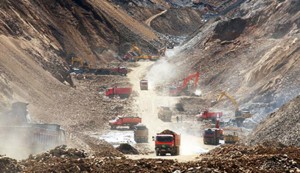The natural Tibetan landscape of rolling plains, towering mountains, forests, lakes and rivers is being dramatically changed through a combination of factors which are mostly man made. The changes are nearly all detrimental to the country’s ecosystem and will ultimately impact, not only the Tibetan people, but those living in adjacent countries as well. While climate change is affecting the region’s rainfall pattern and causing glaciers to retreat with significant implications for the region’s ecology, the greater danger to the Tibetan environment is, arguably, industrial activity and changed agricultural practices.
 One of the driving factors for the Chinese invasion in 1949 was the quest for rare and precious minerals to fuel industrial growth. According to Chinese statistics, there are over 126 different minerals in Tibet including copper, gold, uranium, borax and iron which Tibet has in abundance and which are rapidly being depleted in China itself. Tibet’s landscape has been transformed with roads, railways, mines, housing and hydropower plants to support the harvesting of these materials and, as a result, rich agricultural land has been lost, water sources polluted and soil contaminated. According to Chinese estimates, at least 30 percent of Tibet’s arable land is now considered degraded.
One of the driving factors for the Chinese invasion in 1949 was the quest for rare and precious minerals to fuel industrial growth. According to Chinese statistics, there are over 126 different minerals in Tibet including copper, gold, uranium, borax and iron which Tibet has in abundance and which are rapidly being depleted in China itself. Tibet’s landscape has been transformed with roads, railways, mines, housing and hydropower plants to support the harvesting of these materials and, as a result, rich agricultural land has been lost, water sources polluted and soil contaminated. According to Chinese estimates, at least 30 percent of Tibet’s arable land is now considered degraded.
China is also harvesting Tibet’s timber, having systematically destroyed 98% of its own forests, primarily for industrial fuel, since their ‘Great Leap Forward’ (in 1958-1961). Parts of south and eastern Tibet have some of the best quality forests in the world, with trees averaging 90ft high and girths of 5ft or more in diameter, but these are now being destroyed indiscriminately and reforestation is often neglected or ineffective.
Tibet’s forest cover shrank by 46% between 1959 and 1985 and, although more recent figures are not available, it is speculated that forests have been decreasing daily since then. It is a fact that in some areas up to 80% of forest cover has been removed. Most of Tibet’s forests are on steep, isolated river valleys so deforestation on this scale leaves hillsides prone to soil erosion with resulting landslides, water silting, soil degradation and habitat loss, again affecting millions of people across South and South East Asia. Deforestation also adds significantly to global warming because sequestered carbon is released once trees are felled.
Agricultural reforms enforced by China in the 1960s have also caused extensive damage to the natural environment. Up to 70% of Tibet is covered in grassland sustaining about 70 million animals and almost a million nomadic herdsman tending their yak, sheep and goats. However, over the last 40 years much marginal pasture has been taken for intensive agriculture by Chinese Han settlers. Resettlement programmes have relocated thousands of Tibetan nomads, who China unfairly blamed for the damage to pastureland, and Tibetan farmers have been forced to use fertilizers and insecticides which is contrary to their natural organic method of agriculture. Many herbs used for traditional medicine, food plants and the winter food supply for wildlife has been irretrievably lost. All of this has resulted in widespread desertification, especially in Amdo, and the land is now no good for grazing nor agriculture. In addition, large areas of pasture have been fenced off for the Chinese army’s horses, sheep and cattle, reducing the traditional migration routes of Tibetan nomads and affecting the life and livelihoods of the people and their animals.
Wildlife loss is another major concern. The destruction of native forests has resulted in the loss of habitat for many rare animal species, including the giant panda and golden monkey, as well as over five thousand unique plant species. Before the Chinese invasion, Tibet had vast herds of large mammals roaming the plains, including antelope, gazelle, blue sheep and wild yak and there was a strict ban on hunting wild animals. Since 1950 hunting restrictions have not been enforced, indeed, trophy hunting (which attracts lucrative foreign investment) and poaching for wild meat, has escalated so that, together with the shrinking pastureland, the survival of many species, including the snow leopard, is threatened.
Perhaps the greatest human tragedy resulting from China’s exploitation of Tibet is the threat to the culture and traditions of the Tibetan people as the massive influx of Chinese civilians and military personnel dilute the Tibetan way of life. Today, Tibetans are now outnumbered by almost 2:1 and are rapidly becoming marginalized in the employment, education, religious and social arenas of their own country.
What of the future? International concern has been raised by the threats to global warming, habitat and species loss and water security in Tibet. China is therefore under increasing pressure to change her current policies but perhaps the most potent arguments will, in the end, be economic ones. Investment in solar power would be less destructive (and less expensive) than hydropower, more efficient industrial practices would be more economical in the long term and clean water at source would be more cost-effective than purification plants downstream. Also, while some economic development is undoubtedly beneficial for Tibet, there are less damaging ways of making it happen. For instance, eco-tourism is a far better alternative to hunting and the development of an eco-industry for local products and herbal medicines would create employment opportunities for local people and help protect both the fragile environment and the traditional Tibetan way of life.




 Print
Print Email
Email